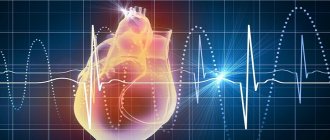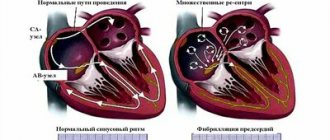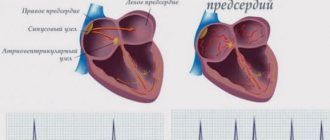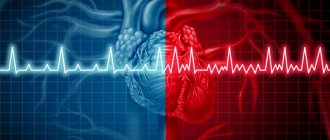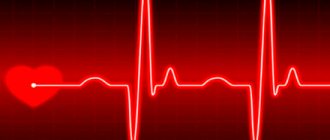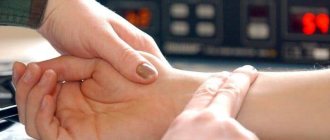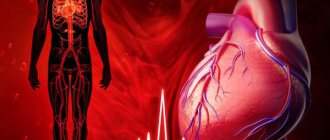Atrial fibrillation is a common heart rhythm disorder. If the heart functions normally, with each beat there is a sequential contraction of its parts. With atrial fibrillation, the two atria lose the ability to contract harmoniously and do not so much beat as twitch randomly - “flicker”.
As a result of this disorder, blood flow slows down, which leads to the accumulation of blood and the formation of blood clots. Blood clots, once in the blood vessels of the brain, interfere with the blood supply to the brain, causing a stroke, which can be fatal.
Article navigation:
symptoms / causes of occurrence / technologies for determining arrhythmia / tonometers for diagnosing atrial fibrillation
Read in this article:
- What is atrial fibrillation?
- Why is the heart rhythm disrupted?
- Symptoms of atrial fibrillation
- Detection of arrhythmia using a tonometer
- Tonometer with ECG function
- What to do if the device shows arrhythmia?
- Advantages of a tonometer measuring atrial fibrillation
Doctors recommend regularly measuring blood pressure, even if a person is not bothered by problems with the heart and blood vessels. But such monitoring is especially important for those who have a predisposition to cardiovascular pathologies or have been diagnosed with diseases of this nature. This allows you to detect the development of the disease at the earliest stage, prevent complications and take the necessary measures in time.
What is atrial fibrillation?
One of the most common cardiac pathologies is atrial fibrillation. The human heart consists of four chambers that contract synchronously: first the atria, then the ventricles. But for various reasons, a malfunction may occur, as a result of which the ventricles continue to contract as usual, but the atria do so at an increased frequency.
In this situation, synchrony is disrupted, part of the blood is not ejected from the ventricles into the systemic and pulmonary circulation, the aorta and artery are not completely filled with blood. As a result, there is a risk of stagnation, and this is fraught with the formation of blood clots. This condition is very dangerous, since the resulting blood clots can get stuck in the arteries and cause a heart attack, stroke, intestinal peritonitis, and gangrene of the extremities.
Why is the heart rhythm disrupted?
Quite often it is not possible to identify the exact causes of the development of atrial fibrillation. However, there are several factors that are most likely to cause such disturbances in the functioning of the heart:
- Abuse of alcohol, tobacco;
- Severe emotional stress, stress;
- Hyperthermia, electric shock;
- Obesity, a large amount of excess weight;
- Genetic predisposition, heredity.
Symptoms of atrial fibrillation often appear against the background of other diseases, mainly cardiac: myocarditis and hypertension, ischemia and cardiosclerosis, heart failure and heart defects, both congenital and acquired. The cause of arrhythmia may be a congenital pathology of the heart valve or serious diseases of the thyroid gland, lungs, and kidneys.
Symptoms of atrial fibrillation
Regular failures in the contraction of the ventricles and atria negatively affect the heart muscle and its functions. Recognizing the pathology can be quite difficult due to the similarity of the symptoms of atrial fibrillation with the influence of other factors:
- An accelerated heartbeat is felt;
- Attacks of shortness of breath appear;
- Suddenly your head starts to feel dizzy and hurt;
- There is a feeling of pressing pain in the chest;
- It feels like your heart is beating faster than usual;
- Possible loss of consciousness.
Obviously, such manifestations can be attributed to the body’s reaction to stress, fatigue, and physical activity.
Alarming symptoms should be considered increased headaches, tremors of the limbs, insomnia, as well as regular signs of panic. When the heart rhythm is disturbed, muscle weakness often appears, which interferes with usual physical activity, and sweating is activated.
With atrial fibrillation, the pulse may increase, and then increased sweating, anxiety, and tremors of the limbs appear. In some cases, the heart rate decreases. If its value is less than 60 beats per minute, the brain does not have enough oxygen, hence pre-syncope, loss or clouding of consciousness.
If the pulse remains normal, heart rhythm disturbances usually occur asymptomatically. This is especially dangerous because the person does not even know about the development of the pathology, does not seek medical help and does not have the opportunity to prevent dangerous consequences.
Symptoms
The peculiarity of atrial fibrillation is that its symptoms appear periodically and may not be recorded at the time of visiting a doctor or undergoing an electrocardiogram. As a result, the disease will not be detected in a timely manner. On the contrary, early diagnosis of atrial fibrillation, control of hypertension and drug treatment can prevent or significantly delay a possible stroke.
My heart beats like it's about to jump out of my chest, especially if I climb stairs or bend over.
I felt nauseous, dizzy and weak. My heart was beating very fast and I felt like I was suffocating.
I had no symptoms at all, the disease was discovered during a regular examination. It's good that this happened quite early.
This is how patients describe their feelings.
Symptoms of atrial fibrillation include:
- cardiopalmus
- pain and tingling in the chest
- dyspnea
- dizziness
- loss of consciousness
- muscle weakness
- increased sweating
- frequent urination
- unmotivated attacks of fear
Atrial fibrillation or atrial fibrillation is the leading cause of stroke
Atrial fibrillation (AF) is the cause of 20% of all strokes.
The risk of stroke in the presence of AF increases up to 6 times.
Stroke caused by AF significantly increases the risk of mortality.
1% of the adult population and 3-5% of people over 60 years of age have AF.
About 2 million people in Russia have AF.
More than 10% of strokes are caused by asymptomatic AF.
Detection of arrhythmia using a tonometer
The main way to diagnose arrhythmia is an ECG. However, such examination does not always reveal disorders if they appear only from time to time. In addition, routine examinations are carried out at a certain interval, during which pathology can actively develop.
The simplest and most affordable option for monitoring heart rate is to use a tonometer with an arrhythmia indicator. For example, in the Beurer line of pressure measuring instruments, all models are equipped with this function. During the procedure, the device analyzes the rhythm of heart contractions and displays the corresponding icon if the indicator differs from the norm.
The automatic blood pressure monitor detects even small air fluctuations in the cuff chamber. Such differences in air pressure are associated with blood flow in the compressed artery. The oscillations are analyzed, converted into electronic signals and displayed on the screen in the form of symbols or numbers. At the same time, the device records the heart rate. A change in heart rate may also indicate the development of arrhythmia.
How to choose the right tonometer
To find out which tonometer is best to buy for home use, you need to decide what criteria you need to pay attention to first, and what you can easily do without without compromising quality.
- Device type
As we have already found out earlier, for home use, an ordinary person who does not have the necessary skills to measure pressure with a mechanical tonometer is better off opting for automatic models.
Automatic blood pressure monitors, in turn, are divided into the usual shoulder and slightly less common wrist ones, depending on what part of the arm the measurements are taken on. Their operating principle is the same.
Experts say that wrist devices are as accurate as their shoulder-mounted “brothers”; in addition, they are compact in size and light weight, which is convenient if you need to take the device on the road.
You need to use it as follows: attach the cuff to the wrist of your left hand, bring it to the heart area and press the “Start” button. The measurement time is usually about 30 seconds.
Opinions vary regarding the ease of use of automatic wrist blood pressure monitors for older adults. The advantages of this type of device include:
— a convenient display with large numbers that are clearly visible even to people with poor eyesight;
— ease of use;
— light weight and compactness;
— the cuff is convenient to put on and take off without assistance;
- Suitable for people who have problems with limited physical activity.
With all the positive aspects, there are also disadvantages:
- do not fit the full hand;
- high price;
— various age-related deformities of the joints can interfere with the correct application of the cuff;
— injuries in the area of the wrist joint are a contraindication for the use of this type of pressure measuring devices;
- the vessels on the wrists are thinner than in the forearm and wear out faster, which can affect the accuracy of the readings.
Thus, young people can choose any type of device for themselves, but for older relatives it is better to purchase the classic version for the forearm, since it is more universal.
pixabay.com/Gadini
- Features of the user's constitution
The fullness of the hand directly determines which device to give preference to. The standard cuff size is from 22 to 35 cm, but there are options where the sleeve size is 48–56 cm, these are suitable for people who are overweight and suffer from edema. In this case, wrist blood pressure monitors are not suitable at all.
- Availability of built-in memory
A device that stores the results, as well as the date and time of the last measurements, allows you to monitor your pressure over time. If you plan to use the blood pressure monitor with the whole family, look for a device that can remember the readings of different users.
- Other useful features
If you or your relatives suffer from arrhythmia or other cardiovascular diseases, it may make sense to think about buying a more “sophisticated” copy with an arrhythmia diagnostic function, automatic calculation of averages and other intellectual abilities that take into account the owner’s health status in the measurement process.
Whether it makes sense to overpay for such features as, for example, the presence of a WHO color scale that instantly shows deviations from the norm, or the inclusion of an energy saving mode - it’s up to you to decide.
- Power type
The bulk of automatic tonometers on the market are battery-powered or rechargeable. The ability to recharge the device from the mains will eliminate additional costs for frequent replacement of batteries, which inevitably arises with frequent use.
pixabay.com/stevepb
Tonometer with ECG function
There are also blood pressure monitors that measure atrial fibrillation. This is how the Beurer BM 95 device works, which is used not only to determine blood pressure, but also to record an ECG.
During measurements using an electrocardiograph, messages may appear on the screen about:
- Reduced heart rate (bradycardia);
- Increased heart rate (tachycardia);
- Pauses in the cardiac cycle that last more than 2 seconds;
- Heart rhythm disturbances, including due to atrial fibrillation;
- Changes in the shape of curves when recording an ECG due to arrhythmia.
When measuring blood pressure, the device calculates the average heart rate and also compares blood pressure values with the norm established by WHO. The results of this comparison are displayed on a color scale for clarity.
If you have a tendency to arrhythmia, for example, a hereditary predisposition, you should use just such a device. Timely detection of arrhythmia will allow you to take the necessary measures and prevent complications. The same applies to people who have already been diagnosed with heart rhythm disturbances. If you have a tonometer with this function at home, it becomes possible to monitor your heart function at home.
In addition, the Beurer BM 95 can be connected to the CardioExpert application, and then all data will be transferred to a smartphone or computer. This will help the doctor to clearly see the dynamics of the changes taking place, select the necessary diagnostic techniques, and evaluate the effectiveness of the current treatment.
Causes
Factors leading to atrial fibrillation can be divided into two main groups:
Cardiac (heart)
Extracardiac (not cardiac)
- hypertension
- cardiac ischemia
- heart failure
- coronary artery disease
- congenital heart defects
- heart valve defects
- myocarditis
- pericarditis
- heart tumor
- consequences of heart surgery
- chronic obstructive pulmonary disease
- chronic kidney disease
- thyroid diseases
- sleep apnea
- electric shock
- viral infections
- diabetes
- chronic alcoholism
- obesity
- stress
With atrial fibrillation, as a result of a malfunction of the heart, clots (thrombi) can form in the atria, which travel through the bloodstream to the brain and lead to a stroke.
Early detection of atrial fibrillation can reduce the risk of stroke .
What to do if the device shows arrhythmia?
When using a conventional automatic blood pressure monitor with an arrhythmia detection function, it is important to know which icon on the screen indicates an abnormal heart rhythm. This information is in the instructions.
If such a symbol appears on the display following the measurement results, you need to repeat the procedure after 7-10 minutes. During this period, you cannot engage in vigorous activity; it is best to just sit quietly. If the symbol reappears or if arrhythmia is regularly indicated, you should consult a doctor.
It is important to remember that readings from a home blood pressure monitor cannot serve as a basis for making a diagnosis. If the device indicates an irregular heart rhythm, this is an indication for consultation with a cardiologist and an examination, on the basis of which the doctor will draw conclusions.
It should also be remembered that the tonometer can show arrhythmia if a person talks or moves during measurements, takes it after consuming tonic products, or in a state of stress or nervous overexcitation.
Arrhythmology
general information
An arrhythmologist is a specialist who diagnoses and treats heart rhythm pathologies, as well as preventive measures in patients at high risk of developing these deadly conditions.
Cardiac rhythm disturbances can be suspected when suspicious symptoms appear: • attacks of dizziness; • feeling of heartbeat; • feeling of “heart sinking”; • episodes of loss of consciousness; • attacks of shortness of breath; • irregular pulse; • weakness, chest pain, swelling in the legs.
Signs of heart rhythm disturbances are nonspecific and occur in many diseases - from angina pectoris to neuroses. Initial information will be provided by an independent study of the pulse wave on the arm (pulse is too rare or too fast, interruptions), and an electronic tonometer with an “arrhythmia” indication will tell you.
However, not all types of arrhythmias can be diagnosed in this way, so if signs of rhythm disturbance appear, you should contact a specialist in this field.
The arrhythmologist at City Clinical Hospital 31 provides a full range of advisory services: • primary diagnosis; • consultation on the results of the examination; • reception of patients undergoing treatment; • dispensary observation; • checking the installed pacemaker.
How is the appointment going?
1. A consultation with an arrhythmologist begins with a survey of the patient, the purpose of which is to collect information about current complaints, medical history, hereditary predisposition, occupational hazards, and lifestyle features that could influence the development of the disease.
It should be borne in mind that clear answers to questions will help shorten the diagnostic search: • When did the symptoms of the disease first appear? • Are there factors that provoke attacks? • What treatment is currently being given? • What chronic diseases do your immediate family have? • Are there any adverse factors at work? • Are there any bad habits (smoking, coffee, tea, alcohol)?
2. If necessary, the doctor conducts a physical examination (examination that is carried out by the doctor using his senses: inspection, palpation, percussion, auscultation). 3. The doctor examines medical records . 4. After this, the doctor establishes a diagnosis and determines treatment tactics . 5. To clarify the diagnosis and/or correct the treatment plan, the doctor may prescribe additional diagnostic examinations , which you can undergo in our clinic.
Preparing for a consultation
A consultation appointment with an arrhythmologist at City Clinical Hospital 31 does not require special preparation. If you are applying for the first time, just make an appointment and come at the agreed time.
If you were observed in another clinic, you must take with you the results of previous studies. The most informative is Holter monitoring (24-hour ECG monitoring) . You can also present the results of the following studies: • ECG at rest and ECG with an attack of arrhythmia (if it was recorded at the time of the complaint); • ECHO-kg - ultrasound examination of the walls, chambers and valves of the heart, large vessels; • chest x-ray (it will help assess the size and position of the heart, the condition of the lungs); • biochemical blood test (they will help assess the content of cholesterol, electrolytes and other substances); • blood test for thyroid hormones ; • angiography of the coronary arteries ; • prescriptions of medications prescribed by doctors of other specialties that you are currently taking or have recently finished taking; • epicrisis from the hospital or extract from the outpatient card.
If you are going to an appointment to check the operation of a pacemaker, tell the doctor its model in advance so that he can prepare the necessary programmer.
Duration of consultation: 30 minutes. Duration of consultation with pacemaker check: 1 hour.
